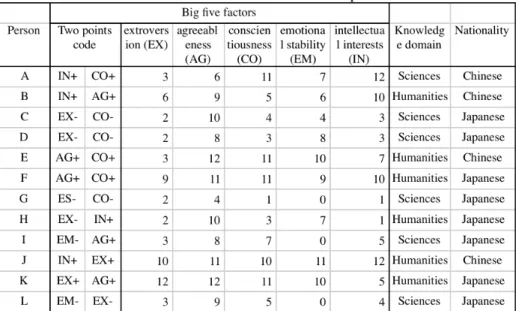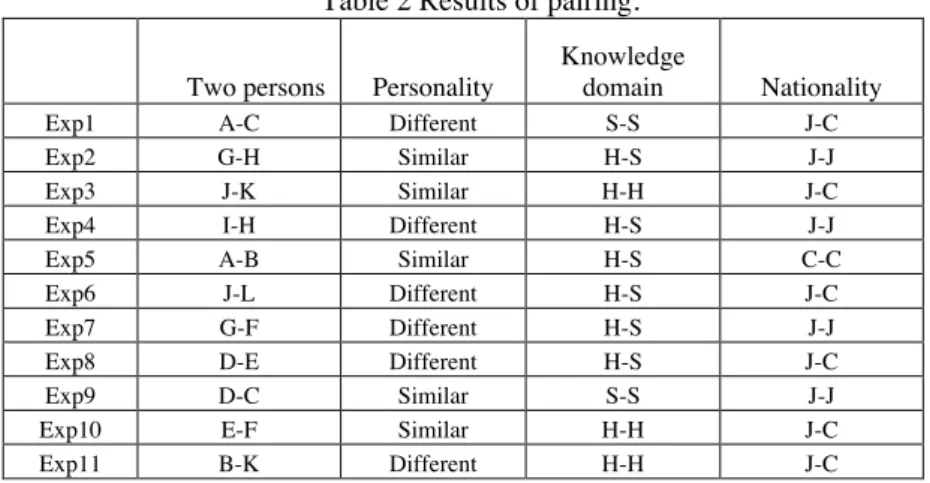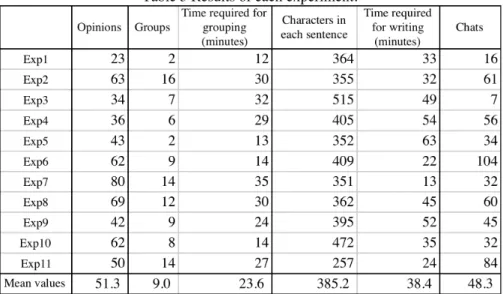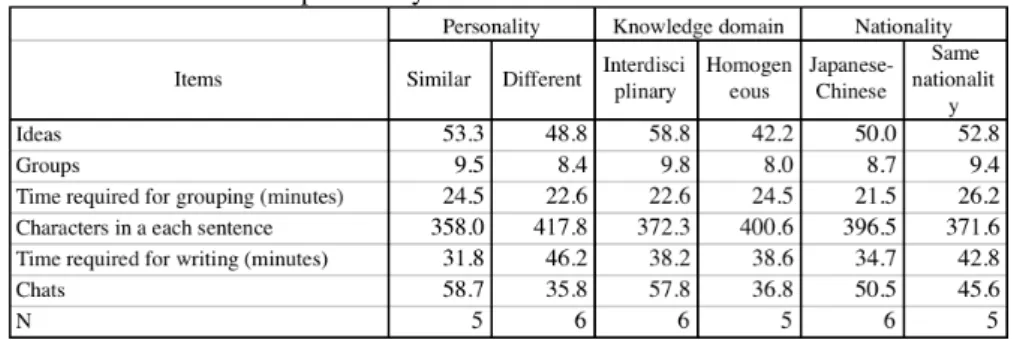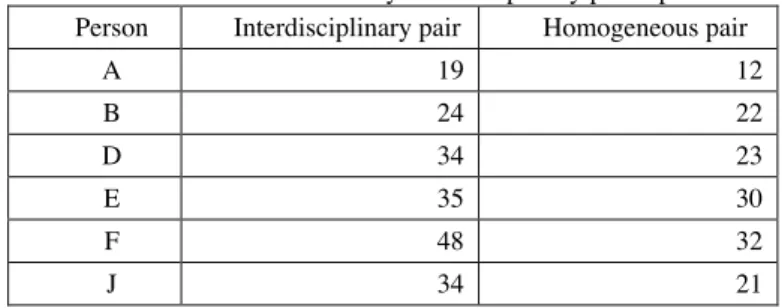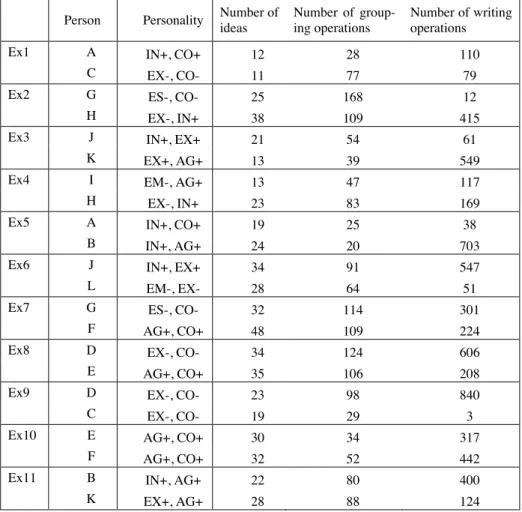Japan Advanced Institute of Science and Technology
JAIST Repository
https://dspace.jaist.ac.jp/
Title
The Effects of Individual Differences in Two
Persons on the Distributed and Cooperative KJ
Method in an Anonymous Environment
Author(s)
Yuizono, Takaya; Jin, Zhe
Citation
Lecture Notes in Computer Science, 6278/2010:
464-472
Issue Date
2010-09-08
Type
Journal Article
Text version
author
URL
http://hdl.handle.net/10119/9569
Rights
This is the author-created version of Springer,
Takaya Yuizono and Zhe Jin, Lecture Notes in
Computer Science, 6278/2010, 2010, 464-472. The
original publication is available at
www.springerlink.com,
http://dx.doi.org/10.1007/978-3-642-15393-8_52
Description
The Effects of Individual Differences in Two Persons on
the Distributed and Cooperative KJ Method in an
Anonymous Environment
Takaya Yuizono1 and Zhe Jin
1 Japan Advanced Institute of Science and Technology,
1-1 Asahidai Nomi, Ishikawa 923-1292, Japan yuizono@jaist.ac.jp
Abstract. The effects of three kinds of individual differences (a difference in the
knowledge domain, a difference in the Big Five personality, and a difference in na-tionality) on a knowledge collaboration of the distributed and cooperative KJ method were examined with a groupware in an anonymous environment. The collaboration method has three steps: brainstorming, grouping, and writing. Twelve individuals participated in the experiment, eight of whom were Japanese and the other four were Chinese. The experimental results revealed the following: (1) Brainstorming by a pair in the interdisciplinary knowledge domain (humanities and sciences) led to the gen-eration of more ideas than by a pair in the homo knowledge domain. (2) Persons pos-sessing a factor called agreeableness in the Big Five factors of personality kept work-ing until the final step.
Key words: groupware, knowledge work, KJ method, individual differences,
per-sonality, knowledge domain, nationality.
1 Introduction
The infusion of the computer network into our daily lives has opened up several opportunities for communication and collaboration via the Internet. In order to sup-port such work, researches about groupware have increased. Researches about an idea generation support system have been advanced in Japan. Such researches support the KJ method [1]. An anthropologist named Jiro Kawakita developed and diffused the KJ method in the 1960s. The groupware research realized a visual editor for the KJ method, for example, KJ-Editor [2] and D-Abductor [3]. Another research supports a distributed form of group work used the KJ method. In order to support the distributed and cooperative KJ method, the GUNGEN (groupware for a new idea generation support system) [4] has been developed and utilized in order to understand how the system and multimedia communication (voice and video) affects the distributed work [4, 5]. These researches aimed to develop and understand technology for idea genera-tion [2–5].
On the other hand, personality is assumed to affect the usage of the groupware. If a person prefers individual work, he or she will display a dislike for group work, as a result of which the quality of the performance of the group work might deteriorate.
In this paper, the effects of individual differences on the distributed and cooperative KJ method with groupware technology were described. The differences were obtained
from the five factors, the knowledge domain (sciences or humanities), and nationality.
2 Related works
Some psychologists think that personality can be explained with the help of five factors; this explanation is called the Big Five [6]. For the Japanese, Murakami et al. classified extroversion, agreeableness, conscientiousness, emotional stability, and intellectual interests as the Big Five [7]. They also developed reliable questionnaires that eliminated the possibility of receiving ambiguous answers; these questionnaires comprised 70 questions for deciding the Big-Five factors.
In GUNGEN [5], video and voice, which form a part of multimedia conferencing tools, affected the text-chat communication to ask the state of the participants but did not affect the various factors, such as time and conclusion, that governed the output performance of the distributed and cooperative KJ method.
It is a well-known fact that computer mediated communication (CMC) has a more profound effect on our decision as compared with face-to-face communication [8]. The results showed that participants with CMC talk with more honesty and equality than those in face-to-face environments. Moreover, the participants tended to avoid a one-man show and produce constructive opinions. On the other hand, the participant tended to express excessive and angry opinions.
3 The Experimental Method
3.1 Procedure
First, we investigated individual properties in terms of three features—personality, knowledge domain, and nationality. Second, we formed pairs with the individual differences for group work. Third, each pair carried out the group work assigned. Finally, we compared these results with the three features.
The task and the environments for the group work are described in 3.3, and the re-sults of these experiments are described and discussed in the next section.
3.2 Decision of difference pairs with three individual features
3.2.1 Collection of three features
We developed web questionnaire systems to collect individual data for personality, knowledge domain, and nationality as a component of culture. The web system was developed with PHP, Apache Web Server, and MySQL database. For personality with the Big-Five test, there are 70 questions, with checkboxes provided wherein the
an-swer is indicated by selecting either “yes” or “no.” Likewise, for the knowledge do-main, checkboxes are provided in which the answer is indicated by choosing from either “humanities” or “sciences.” The same goes for nationality, wherein the options are “Japanese” or “Chinese.”
The data collected through the Web questionnaire system are shown in Table 1. For personality, we scored each of the five factors and used “+” and “-” to indicate high-scoring and low-scoring factors, respectively. If a person had more than two scores with high or low scores, we selected the two factors with a striking difference. In cases of high scores for the extroversion dimension and low scores for the agree-ableness dimension, the personality was coded as “EX+, AG-.”
Table 1 Individual features of each person.
3.2.2 Decision of pairs
A pair was formed depending on the person’s personality, and a pair was judged as similar when the persons constituting the pair showed similarity in more than three of the Big Five factors; on the other hand, a pair was judged as different when the per-sons constituting the pair showed similarity in less than one of the Big Five factors. The result of the pairing is shown in Table 2.
With respect to personality, five similar and six different pairs were formed. With respect to the knowledge domain, six interdisciplinary and five homogeneous pairs were formed. With respect to nationality, six Japanese-Chinese and five same-nation pairs were formed.
Table 2 Results of pairing.
Two persons Personality
Knowledge
domain Nationality
Exp1 A-C Different S-S J-C
Exp2 G-H Similar H-S J-J
Exp3 J-K Similar H-H J-C
Exp4 I-H Different H-S J-J
Exp5 A-B Similar H-S C-C
Exp6 J-L Different H-S J-C
Exp7 G-F Different H-S J-J
Exp8 D-E Different H-S J-C
Exp9 D-C Similar S-S J-J
Exp10 E-F Similar H-H J-C
Exp11 B-K Different H-H J-C
3.3 Tasks and environment
The task called the distributed and cooperative KJ method [3] was adapted to the groupware work by Munemori from the original KJ method. This task has three steps: generating ideas by brainstorming, grouping the ideas as per similarities for concept formation, and framing a concluding statement from the previous steps. With respect to creative style, we use divergent thinking in the first step, convergent thinking with gaps in the second step, and convergent thinking with linear sentences in the final step.
The discussion theme selected is entitled “How to become a president in a big company,” because the theme was appealing to students, and its contents would re-flect aspects of the individual’s personality.
The experiment has been conducted in a distributed and anonymous environment, because the anonymity ensures that the user speaks frankly and honestly. The com-munication media is text-chat comcom-munication only for the purpose of maintaining anonymity. The environment setup is shown in Figure 1.
The KUSANAGI [9], which was groupware and supports the distributed and coop-erative KJ method, was utilized as groupware software for the task. The KUSANAGI supports the concept of showing an opinion as a label and grouping labels, and nam-ing each group on a shared screen. It also supports the framnam-ing of concludnam-ing state-ments on the shared window for writing. A sample screen of a result obtained from the collaboration task is showed in Figure 2. In the screen of the groupware KUSANAGI, the user name is inputted as “A” or “B” instead of a real name to pre-serve anonymity.
The participants in the experiments were twelve graduate students from our univer-sity, and they executed the cooperative task twice. However, the experimental data obtained covers only eleven out of the twelve participants, because two of the partici-pants in one experiment accidentally met, and the experimental data did not come from an anonymous environment.
Figure 1. A shot of an experimental setup.
4 Results and Discussion
4.1 Results
The results of each experiment are shown in Table 3. The results data consist of the number of ideas, the number of groups and time required for grouping, the characters in a concluding statement and time required for writing, and chats for communication. In other hands, the participants answered the seven-scale questionnaires about their interest in the theme, collaboration, and satisfaction rate for the result obtained in each experiment. The results are shown in Table 4, and the overall score is more than the neutral score 4. The participants felt that both oneself and his partner interested in the theme, and they had friendliness with the partner, a good cooperation, and the satis-fied result.
Table 3 Results of each experiment.
Table 4 Results of the seven-scale questionnaires.
Questions Score
Your interest in the theme 5.3
Partner’s interest in the theme 5.2
Friendliness with a partner 5.1
Good cooperation 5.7
4.2 Comparison by three individual differences
Three kinds of individual differences of personality, knowledge domain, and na-tionality are compared in table 5 in order from left to right.
As the first step, the results showed that the difference of knowledge domain affect the idea generation step. The number of ideas in the interdisciplinary pair, which consists of a person in humanities and a person in sciences, was more than the number of ideas in the homogeneous pair, which consists of two persons in humanities or two persons in sciences.
In other hands, there is no difference in the second step of forming groups on the basis of ideas and the last step of writing concluding statements.
Table 5 Comparison by three kinds of individual differences.
To examine the tendency to generate more ideas in the case of interdisciplinary pairs, we investigated the number of ideas obtained per person.
First, the learning effects for the tenth–twelfth persons were investigated, because they executed the cooperative KJ method twice, so it was predicted that the number of ideas in the second execution would be more than that of the ideas in the first. The results indicated no difference between the number of ideas: N = 24.9 in the first execution and N = 26.0 in second execution (T-test, p = 0.79 > 0.10). Therefore, the experience did not affect the number of ideas in the task.
Next, we compared the number of ideas (N = 29.0) by the participants in humaniti-es with the number of ideas (N = 21.6) by the participants in scienchumaniti-es. The rhumaniti-esult indicated the possibility of differences between the two (T-test, p = 0.064 < 0.10). Moreover, we compared the number of ideas (N = 29.4) by the participants in the interdisciplinary pair with the number of ideas (N = 21.1) by participants in the ho-mogeneous pair. The result revealed a meaningful difference between the two (T-test, p = 0.034 < 0.05).
In addition, the number of ideas per a person, who participated both as the interdis-ciplinary pair and as the homogenous pairs, was investigated, the result of which is shown in Table 6. It showed that all the persons offered more ideas in the case of the interdisciplinary pair than those in the case of homogeneous pair.
Table 6 Increase in ideas by interdisciplinary participants. Person Interdisciplinary pair Homogeneous pair
A 19 12 B 24 22 D 34 23 E 35 30 F 48 32 J 34 21
It was assumed that the number of ideas increased in the interdisciplinary pair, be-cause the overlap in knowledge was less, and the persons in the pair could be more knowledgeable than those in the homogeneous pair. When the contents of the ideas were examined, the difference in opinions increased to some extent. In future, the metrics for clarifying such differences by the concept dictionary will be developed and could lead to the revelation of some differences in quality.
4.3 Personality and work process
To consider some effects of personality, the amount of cooperative work executed per participant was investigated, the results of which are presented in Table 7.
Participants who completed less than 20 percent of the work were judged as less cooperative in the task. For example, the rates of person G for writing operations in Ex2 was low—2.8 percent (12/427)—and this person did not work cooperatively in the last step. Looking over table 7, it is evident that the persons with “AG+” personal-ity, which indicates agreeableness with others, were persons B, E, F, L, and, K, and they worked cooperatively from the first step to the last.
In other hands, the effects of the other four factors were not very evident. For ex-ample, the person with the trait of “extroversion” did not chat more than the other persons. In this research, the number of cases was too small to confirm the different varieties of personality.
Table 7 Personality and amount of cooperative work.
Person Personality Number of ideas
Number of group-ing operations
Number of writing operations Ex1 A IN+, CO+ 12 28 110
C EX-, CO- 11 77 79
Ex2 G ES-, CO- 25 168 12 H EX-, IN+ 38 109 415
Ex3 J IN+, EX+ 21 54 61
K EX+, AG+ 13 39 549 Ex4 I EM-, AG+ 13 47 117 H EX-, IN+ 23 83 169
Ex5 A IN+, CO+ 19 25 38
B IN+, AG+ 24 20 703 Ex6 J IN+, EX+ 34 91 547
L EM-, EX- 28 64 51
Ex7 G ES-, CO- 32 114 301 F AG+, CO+ 48 109 224 Ex8 D EX-, CO- 34 124 606 E AG+, CO+ 35 106 208 Ex9 D EX-, CO- 23 98 840
C EX-, CO- 19 29 3
Ex10 E AG+, CO+ 30 34 317 F AG+, CO+ 32 52 442 Ex11 B IN+, AG+ 22 80 400 K EX+, AG+ 28 88 124
5 Conclusions
The effects of the individual differences paired with the distributed and cooperative KJ method were investigated using three factors—personality, the knowledge domain, and nationality. The results showed that the pair in the interdisciplinary knowledge domain had produced more ideas than the pair in the homogeneous knowledge do-main. The persons who possess the agreeable factor within the Big Five personality maintained a cooperative working style throughout the three steps of the distributed and cooperative KJ method.
In future, the metrics for clarifying knowledge differences by the concept diction-ary will be developed and the making an effect of the increased ideas on the post-collaboration steps will be considered.
References
1. Kawakita, J.: Idea Generation Method, Chuokoron-sha, Tokyo (1967) (In Japanese) 2. Yuizono, T., Kayano, A., Shigenobu, T., Yoshino, T., Munemori, J.: Groupware for a New
Idea Generation with the Semantic Chat Conversation Data, R. Khosla et al. (Eds.): KES2005, LNAI, vol. 3681, pp. 1044–50 (2005)
3. Munemori, J., Nagasawa, Y.: GUNGEN: Groupware for a New Idea Generation Support System, Inf. and Soft. Technology, vol. 38, no. 3, pp. 213–220 (1996)
4. Misue, K. et al.: Enhancing D-ABDUCTOR towards a Diagrammatic User Interface Plat-form, Proc. KES’98, pp. 359–368 (1998)
5. Munemori, J., Yuizono, T., Nagasawa, Y.: Effects of Multimedia Communication on GUNGEN (Groupware for an Idea Generation Support System), Proc. of 1999 IEEE Inter-national Conference on Systems, Man, and Cybernetics, vol. II, pp. 196–201 (1999) 6. Ohiwa, H., Takeda, N., Kawai, K., Shimomi, A.: KJ editor: A Card-Handling Tool for
Crea-tive Work Support, Knowledge-Based Systems, vol. 10, pp. 43–50 (1997)
7. Sproull, L., Kiesler, S.: Computers, Networks, and Work. Scientific American, vol. 265, no. 3, pp. 84–91 (1991)
8. In Wikipedia, Big Five Personality Traits, http://en.wikipedia.org/wiki/Big_Five_personality_traits (access on March 19, 2010) 9. Murakami, Y., Murakami, T.: Big Five Handbook, Gakugei-tosho, Tokyo (2001) (In
Japa-nese)
Acknowledgement
This research was partially supported by The Ministry of Education, Culture, Sports, Science and Technology (MEXT) and the Grant-in-Aid for Young Scientists (B) 21700133, 2010.
